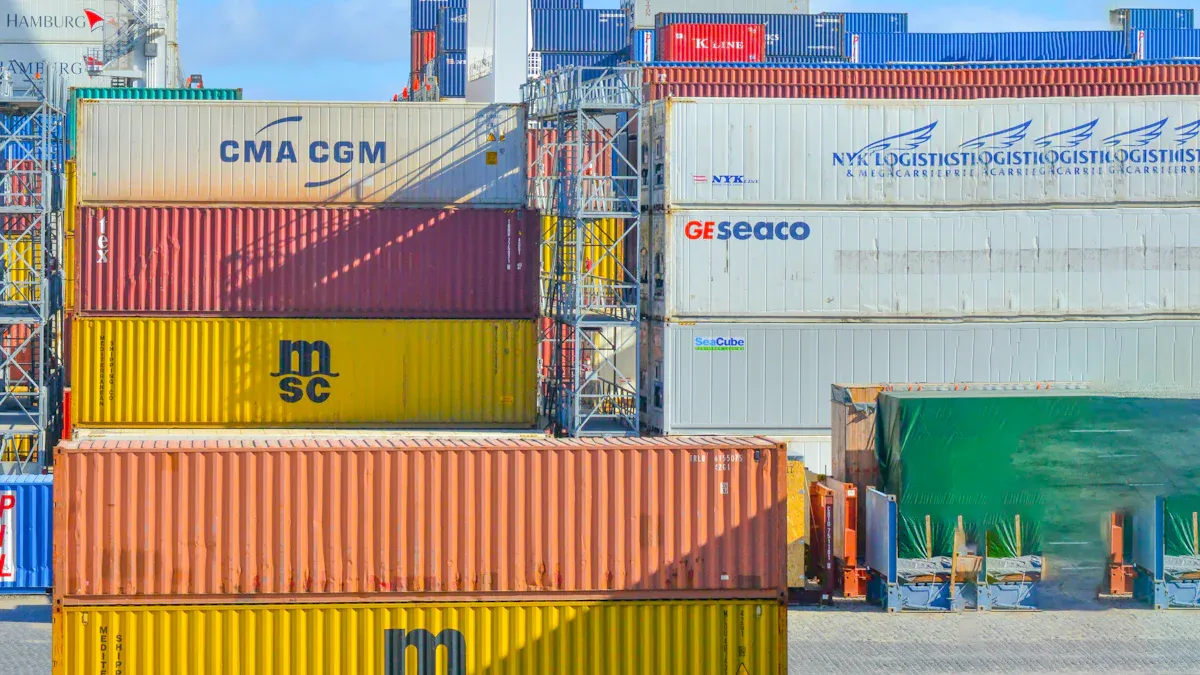How Lean Logistics Planning Enhances Supply Chain Efficiency

Lean logistics planning empowers you to streamline supply chain operations by targeting inefficiencies and reducing waste. Businesses that embrace this approach often see significant results. For example:
A mid-size retailer cut distribution costs by over 20% in just one year.
Their order fulfillment cycle time improved from 48 hours to 36 hours.
These changes not only lower expenses but also enhance performance and customer satisfaction. By focusing on continuous improvement, lean logistics planning ensures your supply chain adapts to challenges and delivers consistent value.
Key Takeaways
Lean logistics planning lowers waste and saves money, boosting efficiency.
Using tools like Value Stream Mapping and Kanban finds problems and improves workflows.
Always working on improvements helps your supply chain stay strong and adjust to changes.
Using technology like live tracking and smart repairs makes operations faster and more flexible.
Creating a lean culture means involving workers and adding lean ideas to your company’s goals for long-term success.
Understanding Lean Logistics Planning
Definition and Core Principles
Lean logistics planning focuses on eliminating waste and optimizing processes to create a more efficient supply chain. It emphasizes setting SMART (Specific, Measurable, Achievable, Relevant, Time-bound) targets to drive improvements. By identifying bottlenecks, you can streamline operations and design future value streams that deliver maximum value to customers.
A key principle of lean logistics is lean accounting, which supports decision-making by tracking costs across entire value streams rather than individual departments. This approach provides actionable metrics that help you focus on continuous improvement. Some of its core elements include:
Value Stream Costing: Tracks costs and profitability across value streams.
Decision-Making Support: Offers operational and financial reporting for fact-based decisions.
Continuous Improvement Metrics: Provides timely data to support initiatives like kaizen.
By adopting these principles, you can create a supply chain that is both efficient and adaptable.
Key Components of Lean Logistics
Lean logistics planning relies on several components to achieve its goals. For example, a case study on manual order picking and packing in warehouses demonstrated a 30% efficiency increase by reducing non-value-added processes. This highlights the importance of focusing on activities that directly contribute to customer value.
Key components include:
Streamlined Processes: Simplify workflows to eliminate unnecessary steps.
Waste Reduction: Identify and remove activities that do not add value.
Continuous Improvement: Regularly evaluate and refine processes to maintain efficiency.
These components ensure that your logistics operations remain cost-effective and responsive to changing demands.
The Role of Lean Thinking in Supply Chains
Lean thinking transforms supply chains by integrating efficiency and sustainability. Research studies, such as "Lean Supply Chain 5.0 Management," highlight how lean principles combined with Industry 4.0 technologies improve performance. This approach enables you to adapt to modern challenges while maintaining a focus on customer satisfaction.
The chart below illustrates the growing interest in lean supply chain management over the years:
By adopting lean thinking, you can create a supply chain that is not only efficient but also aligned with long-term sustainability goals.
Benefits of Lean Logistics Planning

Cost Reduction and Waste Minimization
Lean logistics planning helps you cut costs and eliminate waste across your supply chain. By adopting lean transport methods, you can reduce operational expenses by 15-20%, as noted in a Harvard Business Review study. Efficient route planning and load management lower fuel consumption and minimize delays, saving money and time. Preventive measures also reduce risks, such as accidents and disruptions, ensuring smoother operations.
In addition, lean techniques significantly reduce waste. For example, a study on lean waste management found that these methods contributed to a 55% reduction in waste. Using tools like the Analytical Hierarchy Process (AHP), businesses can quantify waste reduction and optimize processes. Companies like General Electric have achieved up to 30% cost savings and 50% waste reduction by implementing lean practices.
Tip: Focus on activities that directly add value to your customers. Streamlining workflows and eliminating non-essential steps can lead to substantial savings.
Enhanced Customer Satisfaction
Lean logistics planning improves customer satisfaction by optimizing delivery speed, accuracy, and overall efficiency. Shorter lead times, achieved through streamlined processes, ensure faster order fulfillment. For instance, tracking lead time reduction from order receipt to delivery completion highlights how lean practices enhance customer experiences.
Metrics such as customer satisfaction scores provide valuable insights into the effectiveness of your logistics system. Higher scores reflect better delivery performance and reduced errors. Waste reduction in transportation and inventory also contributes to improved efficiency, positively impacting customer perceptions.
Metric | Description |
|---|---|
Lead Time Reduction | Tracking the time from order receipt to delivery completion; shorter times enhance satisfaction. |
Waste Reduction Percentage | Monitoring waste in transportation, inventory, and production; lower waste indicates efficiency. |
Customer Satisfaction Scores | Feedback on delivery speed and accuracy; higher scores reflect a well-optimized logistics system. |
Cost Savings | Savings from reduced waste and transport expenses; improved efficiency positively impacts costs. |
By focusing on lean logistics planning, you can deliver consistent value to your customers while maintaining operational excellence.
Improved Agility and Responsiveness
Lean logistics planning enhances your supply chain's agility and responsiveness, especially in dynamic industries. A recent study involving 112 manufacturing companies found that lean practices are essential for achieving operational agility. Flexible resources, pull systems, and quick setups allow you to adapt to changing market demands without compromising efficiency.
In the automotive sector, lean logistics has proven to be a cornerstone of agility. By integrating lean manufacturing with supply chain strategies, businesses can respond quickly to fluctuations in demand and minimize disruptions. This approach ensures that your supply chain remains resilient and capable of meeting customer expectations in real-time.
Note: Agility is not just about speed; it’s about being prepared to pivot and adapt to unforeseen challenges. Lean logistics planning equips you with the tools to stay ahead in competitive markets.
Practical Applications of Lean Logistics Planning
Tools and Techniques for Optimization
To optimize your supply chain, lean logistics planning relies on specific tools and techniques that target inefficiencies. These tools help you identify waste, streamline processes, and improve overall performance.
Some of the most effective tools include:
Value Stream Mapping (VSM): This tool helps you visualize your supply chain processes and identify areas of waste. By mapping out each step, you can pinpoint inefficiencies and focus on value-added activities.
5S Methodology: This technique organizes your workspace for efficiency. It involves five steps: Sort, Set in Order, Shine, Standardize, and Sustain. Implementing 5S reduces clutter and improves workflow.
Kanban Systems: These systems use visual signals to manage inventory and production. They ensure that materials are replenished only when needed, reducing overproduction and excess inventory.
A study conducted in Malaysia analyzed 131 public organizations and found that lean tools significantly enhance performance. The research identified critical success factors such as lean resources, culture, and knowledge management. These factors, when implemented holistically, improve operational efficiency and drive better results.
Tip: Start small by implementing one tool at a time. Gradually expand your efforts to achieve a fully optimized supply chain.
Real-World Examples of Lean Logistics
Real-world applications of lean logistics demonstrate its transformative impact. Companies across industries have successfully implemented lean practices to improve safety, efficiency, and employee satisfaction.
Example | Improvement | Numerical Data |
|---|---|---|
Nedtrain | Safety | |
Nedtrain | Employee Satisfaction | 2.5% absentee rate |
Medical Supplies Distributor | Safety | Complete absence of lift truck accidents |
For instance, Nedtrain, a Dutch train maintenance company, achieved an 80% reduction in accidents by adopting lean practices. This improvement not only enhanced safety but also boosted employee morale, as reflected in their low absentee rate of 2.5%. Similarly, a medical supplies distributor eliminated lift truck accidents entirely, showcasing the effectiveness of lean logistics in creating safer work environments.
These examples highlight how lean logistics planning can deliver measurable benefits, from improved safety to higher employee satisfaction.
Leveraging Technology for Lean Operations
Technology plays a crucial role in enhancing lean logistics operations. By integrating advanced tools, you can achieve greater efficiency, reduce waste, and respond quickly to changes in demand.
Metric | Description | Benefits |
|---|---|---|
Provides up-to-the-minute insights into transportation status. | Enhanced visibility, improved decision making, reduced delays. | |
Predictive maintenance | Utilizes data to foresee vehicle issues before they occur. | Reduces downtime and enhances reliability through timely repairs. |
Adaptive routing | Adjusts delivery routes based on real-time conditions. | Minimizes delays by responding to traffic and other external factors. |
Data analytics | Consolidates tracking information to predict trends and optimize routes. | Ensures lean operations remain agile and responsive to disruptions. |
For example, real-time tracking allows you to monitor shipments and make informed decisions to avoid delays. Predictive maintenance ensures that vehicles remain operational by addressing potential issues before they escalate. Adaptive routing adjusts delivery paths based on traffic conditions, saving time and fuel. Data analytics consolidates all this information, enabling you to identify trends and optimize your supply chain further.
By leveraging these technologies, you can align your logistics operations with lean principles, ensuring they remain efficient and adaptable.
Overcoming Challenges in Lean Logistics Planning
Common Barriers to Implementation
Implementing lean logistics planning often comes with challenges that can hinder its success. Supply chain complexity is one of the most significant obstacles. It can negatively impact performance, even when lean practices aim to improve efficiency. Managers sometimes struggle to understand how this complexity affects lean initiatives, making it difficult to achieve desired outcomes.
Dynamic complexities, such as demand variability and unreliable supplier lead times, can reduce the effectiveness of systems like Kanban and just-in-time (JIT) deliveries.
Deep supplier relationships, while beneficial, may inadvertently complicate logistics instead of simplifying them.
The relationship between lean practices and performance often depends on whether the complexity is strategic or dysfunctional.
To overcome these barriers, you need to assess your supply chain's complexity and determine whether it adds value or creates inefficiencies.
Strategies for Building a Lean Culture
Building a lean culture requires a holistic approach that engages employees at all levels. Companies like Hilti Corporation have successfully embedded lean principles into their operations by focusing on continuous improvement and employee involvement.
Start by integrating lean into your company’s vision and communicating it effectively across teams.
Engage top management to lead by example and address resistance to change.
Use practical tools like Kaizen workshops to implement incremental improvements.
Hilti’s "Lean@Hilti" philosophy emphasizes eliminating waste and improving performance. This approach has led to increased sales and productivity, demonstrating the power of a well-established lean culture.
Tip: Encourage employees to participate in improvement initiatives. Their involvement fosters a sense of ownership and commitment to lean practices.
Ensuring Continuous Improvement
Continuous improvement is the backbone of lean logistics planning. Techniques like the Toyota 3M model (muda, mura, muri) help you identify and eliminate waste, ensuring better processes. Technologies such as automation, AI, and real-time data further enhance efficiency and decision-making.
Kanban and JIT methodologies align production with demand, reducing costs and improving service quality.
Regularly reviewing your processes ensures that your supply chain remains agile and responsive to changes.
Continuous improvement practices not only reduce costs but also enhance customer satisfaction.
By adopting these strategies, you can create a supply chain that evolves with market demands while maintaining lean principles.
Note: Continuous improvement is not a one-time effort. It requires ongoing evaluation and adaptation to sustain long-term success.
The Future of Lean Logistics Planning

Emerging Trends in Lean Supply Chains
Lean supply chains are evolving to meet modern challenges. You can expect several trends to shape the future of logistics planning:
Big Data is transitioning to Fast Data, enabling quicker decision-making.
The Social Supply Chain Era is emerging, where collaboration and transparency take center stage.
Knowledge workers are becoming vital, as their expertise drives innovation and efficiency.
Digital transformation is accelerating through tools like blockchain, IoT, and AI.
Sustainability is gaining focus, with companies prioritizing eco-friendly practices.
A survey from the 2021 Third-Party Logistics Study revealed that 42% of professionals felt supply chains were too lean during the pandemic, while 49% disagreed. This highlights the need for balance. Lean principles must adapt to include inventory buffers, ensuring resilience during demand fluctuations.
The Role of Automation and AI
Automation and AI are revolutionizing lean logistics. These technologies help you reduce waste, improve accuracy, and enhance responsiveness. Companies like Unilever and Amazon demonstrate the transformative impact:
Company | Metric | Improvement |
|---|---|---|
Unilever | Stock waste reduction | |
Unilever | Order fulfillment rate | Improved |
Amazon | On-time Prime shipments | 98% on-time delivery |
Real-time data, predictive analytics, and robotics streamline operations. For example, AI-powered systems optimize inventory levels and forecast demand with precision. Automation ensures faster order processing and minimizes human error. By adopting these technologies, you can achieve a leaner, more efficient supply chain.
Sustainability and Lean Practices
Sustainability is becoming a cornerstone of lean logistics. Combining lean principles with green practices enhances both performance and environmental responsibility. Research shows that this integration reduces energy use, decreases production waste, and improves process cycle times.
Eco-efficiency ratios measure the balance between profitability and environmental impact. Companies that adopt these practices not only meet stakeholder expectations but also gain a competitive edge. For instance, MBA studies highlight businesses that successfully align operational efficiency with eco-friendly initiatives. By prioritizing sustainability, you can future-proof your supply chain while contributing to a healthier planet.
Lean logistics planning transforms supply chain management by reducing waste, cutting costs, and improving efficiency. It enables you to streamline processes, enhance customer satisfaction, and achieve long-term sustainability. The table below highlights its key benefits:
Benefit | Description |
|---|---|
Streamlined processes | Reduces inventory levels and minimizes waste, enhancing overall efficiency. |
Enhanced customer satisfaction | Results from quicker delivery and improved product quality, leading to higher loyalty. |
Improved cost efficiency | Eliminates non-value-adding activities, lowering operational costs. |
Increased flexibility | Allows for prompt responses to customer demands and market fluctuations. |
Better inventory management | Reduces holding costs and overall inventory levels, contributing to financial efficiency. |
Continuous improvement practices | Drives ongoing enhancements in supply chain performance, ensuring sustained efficiency gains. |
As technology and market demands evolve, lean logistics planning will remain a cornerstone of efficient supply chain management.
FAQ
What is the main goal of lean logistics planning?
Lean logistics planning aims to eliminate waste and optimize processes in your supply chain. This approach helps you reduce costs, improve efficiency, and deliver better value to your customers.
How does lean logistics improve customer satisfaction?
It enhances delivery speed, accuracy, and reliability. By reducing lead times and minimizing errors, you can meet customer expectations consistently, leading to higher satisfaction and loyalty.
What tools can you use to implement lean logistics?
You can use tools like Value Stream Mapping (VSM), Kanban systems, and the 5S methodology. These tools help you identify inefficiencies, streamline workflows, and maintain organized operations.
Can small businesses benefit from lean logistics?
Yes, small businesses can benefit significantly. Lean logistics reduces unnecessary costs and improves operational efficiency, helping you compete effectively in the market without requiring large-scale resources.
How does technology support lean logistics?
Technology like real-time tracking, predictive maintenance, and adaptive routing enhances lean logistics. These tools improve visibility, reduce delays, and optimize resource use, ensuring your supply chain remains efficient and responsive.
Tip: Start with simple tools and gradually integrate advanced technologies to align with your business needs.
See Also
Mastering Lean Logistics for Success in High-Tech Manufacturing
Unlocking Logistics Savings: Expert Tips for Supply Chain Success
Understanding Supply Chain Economics for Cost Efficiency
Transforming Logistics Through Innovative Supply Chain Strategies
Harnessing Robotics in Logistics to Boost Warehouse Efficiency
